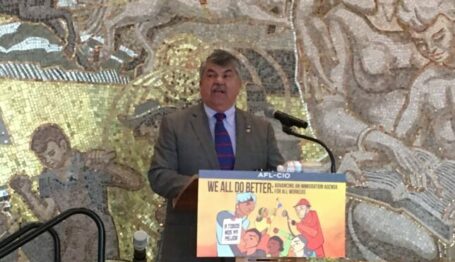Labor Watch
‘Release Time’ Forces Taxpayers to Pay for Union Work: In effect, you’re paying union dues when you pay your taxes
Read Labor Watch PDF here
Summary: Taxpayers expect their government to spend their tax dollars only on activities that benefit the public. Yet across the country, governments at all levels give away tax dollars to the exclusive benefit of government unions—a clear misuse of the public’s money. This subsidy, known as union release time, has flown under the radar for decades, but states are finally starting to do something about it.
A case argued recently before the U.S. Supreme Court threw a spotlight on one of the worst abuses committed by government-employee unions and their allies: the practice of union officials charging taxpayers for time they spend on union business.
For a moment, it appeared, in Friedrichs v. California Teachers Association, that the Supreme Court was prepared to protect the rights of government employees and rein in the power of unions that purport to represent them. On First Amendment grounds, plaintiffs challenged government-employee unions’ practice of taking dues money from members and spending it on political efforts with which those members might disagree.
Justice Antonin Scalia was expected to provide the crucial fifth vote for plaintiffs in the case. After Scalia’s death in February, the vote was tied at 4 to 4, which leaves the lower court’s pro-union/anti-worker ruling in effect.
Unions had prepared for the expected loss by putting money aside. Now that money can be used to get pro-union politicians elected in 2016 and beyond. In These Times, a socialist/union publication, reported that “the ‘rainy day’ savings that many unions made in anticipation of an adverse decision can now be used as a ‘Scalia Dividend’ to be invested in new campaigns.”
Friedrichs means that thousands if not millions of public-sector workers must still pay tribute to a union they may disagree with, and for which they likely didn’t even vote for. That’s right: Most union members in the public sector never voted to join a union. Unions usually operate by the “one person, one vote, once” rule—that, like control by the ruling party in a one-party dictatorship, unionization is inherited from one generation to the next without new generations having any say in the matter.
In a 2012 paper, Vincent Vernuccio of the Mackinac Center noted the results of such an arrangement:
Since most government unions organized in the 1960s and ’70s, few, if any, of the public employees who voted for those unions are still on the job. In Florida and Michigan, for example, just one percent of teachers in the 10 largest school districts were employed when their union was organized.
In the Ann Arbor, Detroit and Grand Rapids school districts there are likely no current teachers who voted for the unions that operate there, since these unions were organized in 1965. Further, if the age distribution of teachers in these districts mirrors that of the state as a whole, nearly 75 percent of the teachers working in these districts would not have even been born when the union in their workplace was certified.
Government-employee unions claim the power to represent, in the political process, members who never chose to join—and, worse, they make you pay for it.



